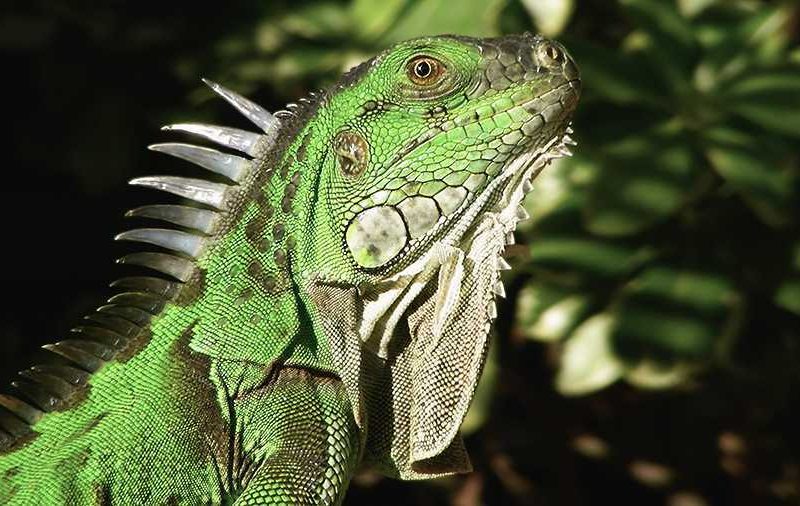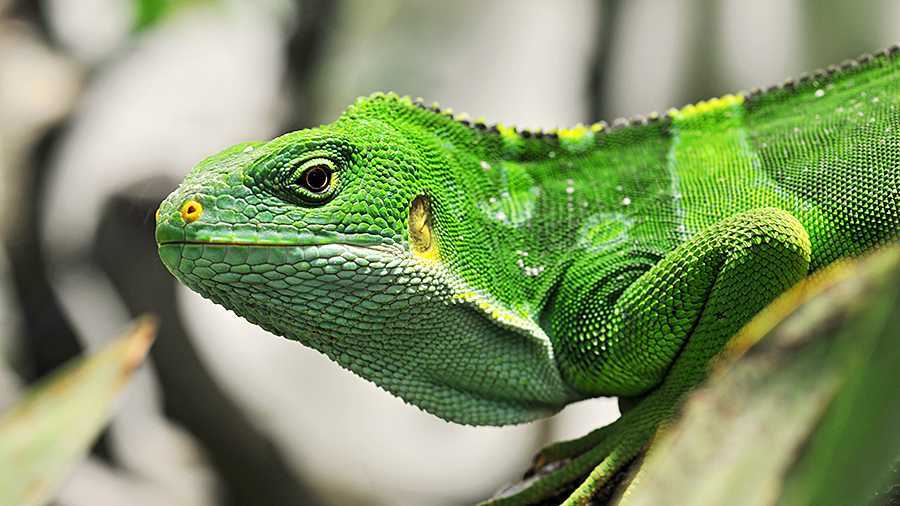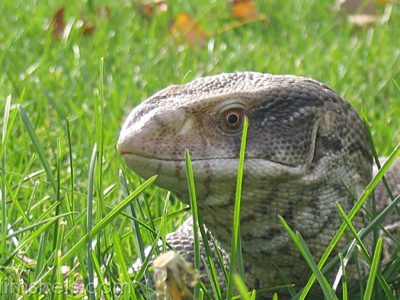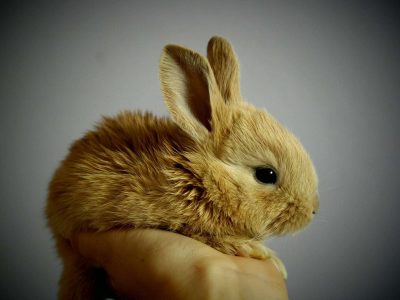
Natural History of Green Iguanas
Green Iguanas are semi-arboreal herbivores found from Mexico to Brazil. Iguanas are generally found close to water, feeding on various types of foliage and basking in the sun during the day and sleeping on branches over the water at night. They are not territorial (except during the breeding season), but they prefer to maintain a certain distance between themselves and other iguanas. During breeding season (November to April), males become aggressive towards other males, and the larger ones form territories which they defend vigorously. Females dig burrows in which to lay their eggs between February and April and lay an average of 40 eggs (20-60). Incubation is about 90 days. At one year of age, a wild iguana measures about three feet long, nose to tip of tail.
Sexing
After two or three years, it is easy to sex iguanas. The males have very large femoral pores (2-3mm in diameter) compared to females. They also have prominent hemipenal bulges on the base of their tails, and larger jowls, dewlaps, spines and facial scales.
Housing
With good nutrition and husbandry, captive iguanas grow rapidly. Owners should buy a large cage to start with, or be prepared to buy one eventually. Most owners build their own or have it custom made, from plexiglass, glass, sealed wood and/or screen. It is important to give iguanas as much vertical space as possible, since they are an arboreal species. If more than one iguana is owned, they should ideally be kept in separate cages, since the larger one will dominate the food and heat sources over the smaller one, which could result in health problems. The larger one might also injure the smaller one if it becomes aggressive during the mating season.
The ideal substrate for the cage bottom is newspaper. It is cheap and easy to clean. If artificial turf is used, three or four pieces should be used in rotation to allow time for thorough cleaning and drying of the used piece. Other things that can be used include large wood chips (large enough that they cannot eat them), sphagnum moss or orchid bark. These organic substrates must be scooped weekly and replaced every two to three months. Avoid sand, gravel, dirt, crushed corn cobs, wood shavings and walnut shells, as the iguana may cause a stomach impaction by eating them. The organic ones also grow fungus readily, which can cause severe respiratory disease and death.
Hardwood branches large enough to climb should be used in the cage. Water should always be available, in a large easily cleanable dish deep enough for the iguana to immerse themselves fully. The water should be cleaned at least three times per week. It is important during shedding that the iguana be able to immerse itself to ensure that the skin comes off completely.
There should be a basking area for the iguana, with a heat source and a full spectrum light (providing ultraviolet [UV] light between 290 and 320 nm wavelength) side by side (as reptiles bask where there is light, not heat), covered with screens protecting the iguana from burns. Full spectrum lightbulbs do not provide a wide enough spectrum of light, so an additional UV black light is needed. Brands of full spectrum bulbs include Vitalite (Durotest), Chroma-50 (GE) and Colortone-50 (Westinghouse). Replace full spectrum and UV black light bulbs (even fluorescent ones) every 6 months, since the UV output stops before the visible output does. Many bulb combinations can be used (incandescent, fluorescent, infrared heat lamps), but keep in mind the necessary components: heat, UV light and visible light (iguanas use this to find the heat).
Locating the cage next to a window is not enough; glass filters out most of the UV light. When the outside temperature is over 70 degrees, the iguana should be exposed to sunlight as much as possible, either through a window screen or in an outside enclosure. If kept outside, make sure the iguana is kept safe from predators and is able to go in some shade if it wants to. The light should be on for around 12-15 hours a day; the time should vary according to season.
Incorrect temperature, along with incorrect diet and lack of UV light, causes the vast majority of captive iguana deaths. The basking area should be 100-105 degrees F, and the other end of the cage should be 80-85 degrees F. At night the temperature should not go below 75 degrees. The temperature should be maintained with light or heat bulbs only heat strips or heating pads should be used cautiously and only as a last resort. “Hot Rocks” or the like should never be used — too many iguanas are burned as a result of these rocks overheating.

Diet
Young growing iguanas should be fed a diet containing about 15% protein-rich foods and 85% vegetables having a positive calcium:phosphorus ratio. When they reach three years old, the diet should be closer to 5% high protein foods and 95% vegetables. Vegetables which have a positive Ca:PO4 ratio include the following: Collard greens, Mustard, Turnip greens (tops), Alfalfa hay, Bok-choy, Broccoli leaves and stems, Beets, Pea pods, Dandelion leaves and flowers, and Hibiscus flowers. These should be the basis (50% or more) of the diet. Other vegetables that can be fed to provide variety include kale, beet greens, parsley, kohlrabi, Romaine lettuce, spinach, sprouts, peppers, cucumbers, okra, carrots, pea pods, squash, green beans and “mixed vegetables.” All vegetables should be washed thoroughly, thawed to room temperature and uncooked.
Fruits should not constitute more than 10% of the diet, since they are very low in minerals.The exception is Figs, which have a high Ca:PO4 and may be fed more often.
Foods that may be used as the protein-rich portion of the diet include whole goldfish, baby or adult mice, legumes (beans — soak them but don’t cook them), tofu, hard boiled or scrambled eggs, insects (mealworms, waxworms, crickets), and earthworms. Light dog food, monkey food, trout food or parrot food may be fed in very small amounts and only rarely. If they were made for iguanas, they would be called iguana food. Never feed puppy food or cat food to your iguana — the high protein content can cause severe kidney damage.
Vitamin supplements are not needed with the diet described above; in fact, their use may result in overdose and toxicity of certain vitamins and minerals.
Young iguanas should be fed every day, but once they reach a year old, they may be fed every two to three days. Feed young iguanas their food chopped up small and mixed well so they cannot pick out their favorite food and only eat that. This will also facilitate the introduction of new foods. The more variety in the diet, the healthier the diet will be, so mix in new foods every week or so.
Common Medical Problems
Metabolic Bone Disease (MBD) Also called hypocalcemia, osteomalacia, calcium deficiency or rickets. MBD is the most common problem in captive iguanas, caused by improper diet, lack of UV light, incorrect temperature in the enclosure, or any combination of the three. It results in a decrease in bone density throughout the body, which then results in fractures. Some common sites for fractures include the long bones of the legs, the spine and the lower jaw. This is usually a disease of young growing iguanas, although adults can get it, especially gravid females.
Metastatic Mineralization. This is the opposite of MBD, in that it is caused by an excess of calcium or vitamin D3, due to an oversupplementation of one or both of these. It can also be caused by feeding dog, cat or monkey food. The disease is characterized by deposits of calcium in soft tissues such as blood vessels, kidneys and lungs.
Treatment:
- Provide temperature gradient of 85-95 degrees with a 100 degree hot spot under a light.
- Sprinkle reptical on food (if injection makes him feel better)
- Get new ultraviolet B light if current one is older than 6 months
- Soak in warm water 10-20 min 1-2 times daily
- Remove branches from cage so he doesn’t break any legs
Resources
Find out more about green iguanas.
References:
Boyer, TH. “Green Iguana Care” and “Veterinary Care of the Green Iguana.” Conference Proceedings, University of Wisconsin Madison School of Veterinary Medicine. 1994.
Jenkins, J. Personal correspondence.1995.Mader, D. Reptile Medicine and Surgery, 2006.



